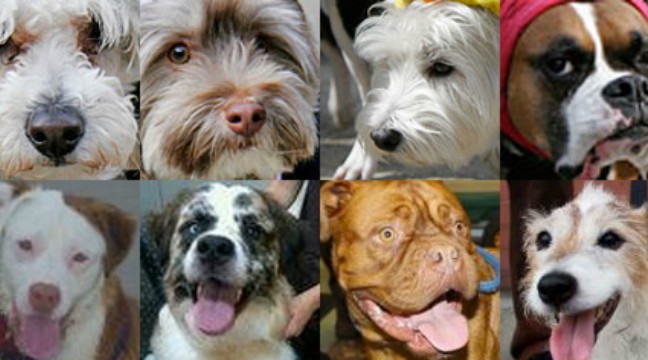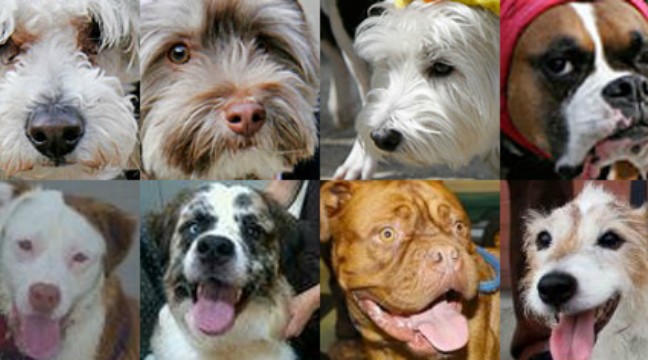
17 OctHumane Halloween 2016: A cone for every season
Halloween can be a scary time… for a dog.
Dog costumes have hit an all-time popularity level, but as a species that is unaccustomed to wearing clothes, playing dress-up can be stressful. You can tell this by just looking at all the stressed-dog facial expressions visible in so many pet Halloween photos.

One row of faces of dogs at a shelter, and a row of faces of dogs in costumes. Can you guess which row is which?
Common signs of stress to look for: tongue flicked out, ears back, eyes wide, lips pulled back taut, yawning. If stress is bad in humans, it is worse in dogs: Stressed dogs are on their way to becoming biting dogs, and that can lead to very stressed humans.
Solution? Either don't put your dog in a costume or train your dog to like being in a costume, by acclimating him to it early. This can be done simply, and in short bursts, by spending the days (or ideally weeks) prior to Halloween having your dog eat all of his meals while wearing his costume.
But ask yourself this: if you're going to spend any amount of time training your dog to wear something silly, why not teach him to wear something silly that he might actually need to wear in the future? This is why, for our second annual Humane Halloween event, we are hosting a Cone Craft Night at School For The Dogs, led by Brooklyn Craft Company. Join us Oct 28 from 7 to 9 for this fun event! The cost is $20 for members, $30 for non-members. Craft supplies will be provided, although you are also welcome to bring your own. There are a limited number of spots, and only a select few member dogs will be allowed to attend.
We have cones available for $10 a piece for advance purchase in our shop, or you can bring your own cone (they are available in most pet stores and on Amazon — we particularly like this style).
It is a good idea to get the cone you'll be using ASAP so that you can start training your dog to love it! This Halloween appropriate will help him have fun during the festivities, even if he doesn't realize how awesome his costume is.

How to train your dog to wear a cone
Step 1: Create a good association:
Pair the experience of wearing the cone with something really delicious. If you can't think of what your dog might enjoy, try peanut butter. Put the cone on, feed peanut butter. Be generous! Take the cone off, and the peanut butter goes away, too. This can be done in a few short sessions every day. If your dog is too stressed to eat while wearing the cone, don't force it. You might instead choose to start by simply leaving the cone out in your home so that its novelty wears off. All the better if you sprinkle treats around it now and then.
Step 2: Teach putting the head through:
If your dog knows how to touch a hand or an object like a target stick, you can put one or the other all the way through the hole and let your dog touch it. Click and treat. Progressively bring your hand back towards you through the hole, encouraging your dog to put his nose through the hole to reach the hand or stick. When this becomes easy, wait for him to put more of his head through before you click and treat.
Step 3: Teach putting it on:
Most things in life are less stressful if they're not forced upon. That is why teaching a dog to put on his own cone can reduce his fear of it. Start by setting the cone down flat, with the wide part facing up. If it doesn't stay still that way, you may have to hold it in place. Put a treat in the center and let your dog eat it. Do this three times. The fourth time, wait for him to start looking for the treat in the center (even though there isn't one) and then click and treat (place treat just outside of the cone). This will help teach him to try putting his head through it even when there isn't a visible treat there. Once he seems to have figured out Oh I just have to bob my head into this thing and a treat appears, flip the cone over so your dog now has to put his head through the smaller part of the cone. Start off with the cone at its largest setting, and hold it down (if you need to) to prevent him picking it up with his head the first few times. Start like you did the first time, with him going towards a treat that is already in the cone, and then move up to clicking and treating him for putting his head into it even when there is no visible treat. Once he seems very comfortable bobbing his head in and out of the cone, you can begin clicking/treating it when he starts to bring his head back up with the cone on.



